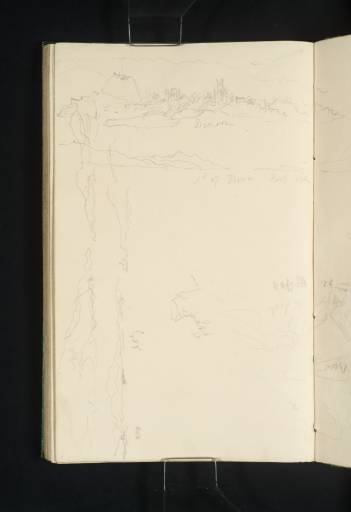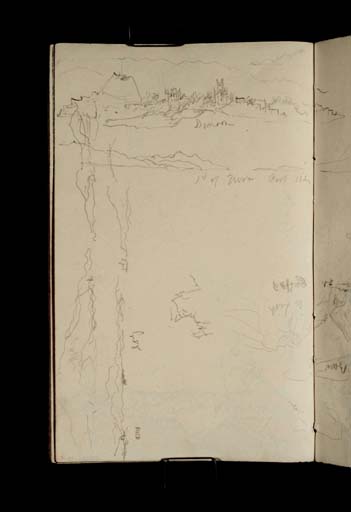Joseph Mallord William Turner Sketches of Dunoon from the Forth of Clyde; Jura and Islay, and Other Locations in Argyll 1831
Image 1 of 2
Joseph Mallord William Turner,
Sketches of Dunoon from the Forth of Clyde; Jura and Islay, and Other Locations in Argyll
1831
Joseph Mallord William Turner 1775–1851
Folio 68 Verso:
Sketches of Dunoon from the Forth of Clyde; Jura and Islay, and Other Locations in Argyll 1831
D26571
Turner Bequest CCLXX 68a
Turner Bequest CCLXX 68a
Pencil on white wove paper, 201 x 125 mm
Inscribed in pencil by Turner ‘Dunoon’ top centre, ‘sd of Jura Port Islay’ upper centre, ‘Islay’ left running vertically
Inscribed in pencil by Turner ‘Dunoon’ top centre, ‘sd of Jura Port Islay’ upper centre, ‘Islay’ left running vertically
Accepted by the nation as part of the Turner Bequest 1856
References
1909
A.J. Finberg, A Complete Inventory of the Drawings of the Turner Bequest, London 1909, vol.II, p.870, CCLXX 68a, as ‘“Dunoon,” &c.’.
This page has been used for a number of sketches of different subjects, made at different times and with the page turned in different directions.
During his steamboat journey to Islay along the Firth of Clyde (see folio 15; D26464 for details), Turner’s boat stopped briefly at Dunoon,1 making the sketch at the head of the page as he approached the pier. This view is therefore from the east near Gartock Rocks, and includes three landmarks: Castle Hill at the left, Castle House (now a museum) at the centre, and the Parish Church (now known as Dunoon Old and St Cuthbert’s Church) at the right. Behind the town is the range of hills to the west.
From Dunoon Turner’s boat continued round the south of the Cowal Peninsula past Toward Point (folio 77 verso; D26589) and round the Isle of Bute, before entering Loch Fyne briefly to reach East Tarbert (folio 88 verso; D26610). From here he continued his journey by land across the Kintyre Peninsula to catch another boat to Islay. Turner approached Islay from the Sound of Islay, which is represented in the second sketch on the page, although here he calls it ‘Sd of Jura’. Looking north up the Sound, Islay is on the left and Jura, continuing on folio 69 (D26572), is on the right.
These two islands are probably represented again in the two sketches drawn along the left edge of the page, with the book turned to the right. The second sketch may be inscribed ‘Islay’. It shows Islay on the left with Jura on the left and the ruin of Claig Castle on Am Fraoch Eilean, a rock just off the coast of Jura (see folio 79 verso; D26593). This ruin is represented again in a rough sketch at the centre of the page. At the right of the page is the slight continuation of a sketch on folio 69 (D26572).
Thomas Ardill
June 2010
James Lumsden and Son, Lumsden and Son’s Steamboat Companion; or Stranger’s Guide to the Western Isles and Highlands of Scotland, Glasgow 1839, p.104; David Wallace-Hadrill and Janet Carolan have speculated that Turner used an earlier edition of this book to plan his routes around the Clyde and Argyll lochs; David Wallace-Hadrill and Janet Carolan, ‘Turner Round the Clyde and Islay – 1831’, 1991, Tate catalogue files.
How to cite
Thomas Ardill, ‘Sketches of Dunoon from the Forth of Clyde; Jura and Islay, and Other Locations in Argyll 1831 by Joseph Mallord William Turner’, catalogue entry, June 2010, in David Blayney Brown (ed.), J.M.W. Turner: Sketchbooks, Drawings and Watercolours, Tate Research Publication, December 2012, https://www


